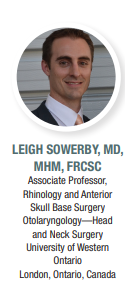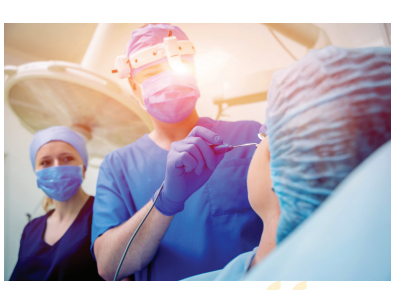With Leigh Sowerby, MD, MHM, FRCSC

“Live SARS-CoV-2 has been found in body fluids such as saliva, sputum, and blood; and the virus can remain viable in aerosols for at least 3 hours.1-3 Such findings have raised safety concerns for surgical staff, including procedures involving high viral-titer tissue sites subject to cautery,” said Leigh J. Sowerby, MD, MHM, FRCSC.
While significant progress has been made, COVID-19 continues to spread uncertainty and fear across global healthcare communities. In an effort to clear up some of the smoke behind the clouds of doubt, Dr. Sowerby and colleagues examined electrocautery plume for the presence of aerosolized viral particles in a recent article.4
“In surgical simulations, we applied a viral load of SARS-CoV-2 approximating what would be present in the pulmonary sputum of asymptomatic patient to raw chicken breast and performed monopolar cut, monopolar coagulate, and bipolar electrocautery,” he explained. “Even though supraphysiologic viral loads were used in all instances, virus was not detected in aerosolized cautery plume in any of the simulations.”
Dr. Sowerby and co-authors concluded that electrocautery smoke is unlikely to transmit SARS-CoV-2 to healthcare workers.
“Our results were not surprising. It is well established that SARS-CoV-2 is a heat-sensitive virus, so the thermal energy generated by electrocautery should be enough to inactivate/destroy it,” Dr. Sowerby said. “This should allow dermatologist surgeons to feel comfortable using electrocautery for hemostasis without any concern for aerosolization of viable virus from blood of patients.”
However, Dr. Sowerby noted the study was limited by the in vitro nature of the experiment, and that collecting cautery plumes from airway surgery in patients with active SARS-CoV-2 would be definitive.
“Future work investigating the plume associated with lower-temperature thermal surgery, such as coblation or carbon dioxide (CO2) laser, and different tissue substrates is warranted. Our next step is to look at aerosolization with a CO2 laser, so stay tuned,” he said.
“The impetus for this study came at the beginning of the COVID-19 pandemic,” Dr. Sowerby said. “Much has evolved since April 2020, including the knowledge that blood-borne SARS-CoV-2, even in those with a high respiratory viral load, is quite low.”
Yet despite increased knowledge of the nature of COVID-19 transmission, Dr. Sowerby recommends continued caution.
“I believe dermatologic surgeons have a higher risk of exposure/infection via breath exhalation when working in the perifacial region with unmasked patients, given the time needed to perform these procedures.
“Our results provide some reassurance that the cautery smoke itself is unlikely to cause an exposure,” Dr. Sowerby noted. “That being said, if being done on awake patients, their exhalation/coughing/expectoration would be a higher risk for exposure. In the operating room, under a general anesthetic with an endotracheal tube, this risk is removed.”
For procedures on awake, unmasked patients, dermatologists should continue to be vigilant when it comes to personal protection, advised Dr. Sowerby.
“Exhalation will be far and away the biggest risk of exposure, so if a patient cannot wear a mask either for personal reasons or due to the location of the lesion, or depending on community levels of COVID-19, I would still recommend wearing high-level PPE given proximity to patients during the procedure.”
Vaccinations remain critical as well, Dr. Sowerby emphasized.
“Vaccinations continue to improve our potential for moving past this pandemic,” he said. “Ensuring vaccination of healthcare workers with potential exposures and lab workers doing research with SARS-CoV-2 is very important.”
By Nayda Rondon
REFERENCES:
- van Doremalen N, Bushmaker T, Morris DH, et al. Aerosol and surface stability of SARS-CoV-2 as compared with SARS-CoV-1. N Engl J Med. 2020;382(16):1564-1567. doi:10.1056/NEJMc2004973.
- Zakka K, Erridge S, Chidambaram S, et al. PanSurg collaborative group. Electrocautery, diathermy, and surgical energy devices: are surgical teams at risk during the COVID-19 pandemic? Ann Surg. 2020;272(3):e257-e262. doi:10.1097/SLA.0000000000004112.
- Sawchuk WS, Weber PJ, Lowy DR, Dzubow LM. Infectious papillomavirus in the vapor of warts treated with carbon dioxide laser or electrocoagulation: detection and protection. J Am Acad Dermatol. 1989;21(1):41-49. doi:10.1016/S0190-9622(89)70146-8.
- Sowerby LJ, Nichols AC, Gibson R, et al. Assessing the risk of SARS-CoV-2 transmission via surgical electrocautery plume. JAMA Surg. 2021 May 21. doi:10.1001/jamasurg.2021.2591.
DISCLOSURES: Dr. Sowerby reported personal fees from Medtronic outside the submitted work. Dr. Sommer reported speaking fees from Medtronic and advisory board fees from Sanofi and GlaxoSmithKline relating to biologic treatment for nasal polyps. No other disclosures were reported.



